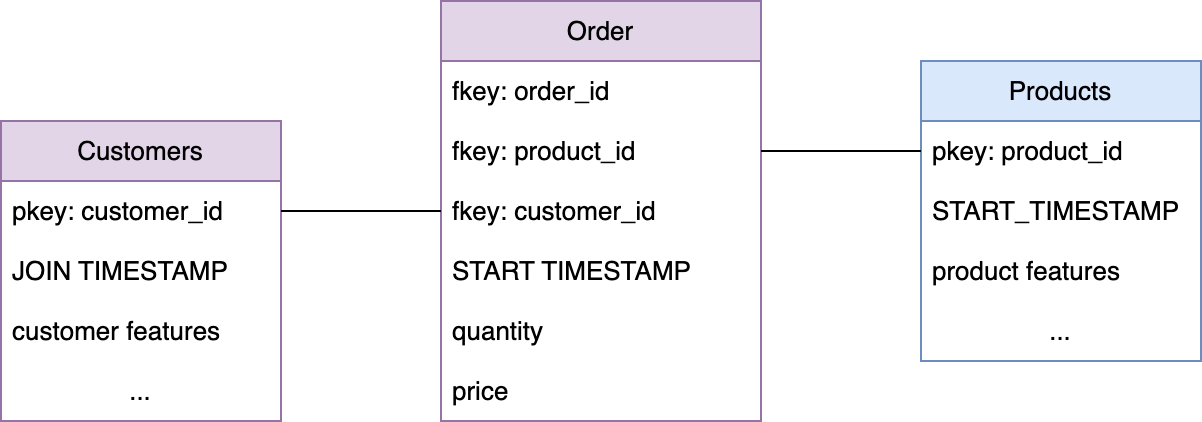Customer Lifetime Value (LTV) Prediction
Solution Background and Business Value
Predicting customer lifetime value (LTV) is a pivotal strategy for businesses aiming to optimize their marketing efforts, enhance customer relationships, and maximize profitability. By accurately forecasting the future revenue a customer is likely to generate, companies can tailor their marketing strategies, allocate resources more effectively, and focus on high-value customers who contribute the most to the bottom line.
LTV prediction can be joined together with other ML models, like churn prediction and coupon affinity models to enables businesses to identify and retain their most valuable customers, reduce churn rates, and enhance customer satisfaction through personalized experiences.
Data Requirements and Kumo Graph
Although you can build an LTV prediction model with a small set of core tables (customers, orders), you can also include many other data sources in your graph. The following is a non-exhaustive list of example tables you can use.

Core tables
- Customers: This table contains basic information about each customer.
- customer_id (Primary Key)
- name
- phone
- registration_date
- address
- Orders: This table captures details about each order placed by customers.
- order_id (Primary Key)
- customer_id (Foreign Key referencing Customers)
- Product_id (Foreign Key referencing Products)
- order_date
- quantity
- price
Additional Table Suggestions
You can extend the graph with more Optional tables:
- (optional) Products: This table holds information about the products sold.
- product_id (Primary Key)
- product_name
- category
- price
- cost
- (optional) Order_events: This table logs events associated with an order.
- order_id (Foreign Key referencing Orders)
- event (payment method, delivery status etc.)
- event_date
- amount
- (optional) Customer_Interactions: This table records customer interactions with the company (e.g., support tickets, feedback).
- interaction_id (Primary Key)
- customer_id (Foreign Key referencing Customers)
- interaction_date
- interaction_type (Support, Feedback, Inquiry, etc.)
- interaction_details
- (optional) Returns: This table tracks returns made by customers.
- return_id (Primary Key)
- order_id (Foreign Key referencing Orders)
- product_id (Foreign Key referencing Products)
- return_date
- return_reason
- refund_amount
- (optional) Customer_Loyalty: This table includes data on customer loyalty programs and points.
- loyalty_id (Primary Key)
- customer_id (Foreign Key referencing Customers)
- loyalty_points
- membership_level (e.g., Bronze, Silver, Gold)
- points_earned
- points_redeemed
- (optional) Marketing_Campaigns: This table tracks marketing efforts targeted at customers.
- campaign_id (Primary Key)
- customer_id (Foreign Key referencing Customers)
- campaign_type (Email, SMS, Social Media, etc.)
- campaign_date
- campaign_response (Opened, Clicked, Ignored)
Predictive Query
LTV metrics can be defined in a variety of ways, depending on what KPIs you are interested in. Here are some example definitions of customer LTV:
- Aggregate total spending per customer from the Orders and Transactions tables in a future timeframe
- A combination purchase frequency, average order value, and return rates.
We can extend the LTV definition by:
- Incorporating data on customer engagement from Customer_Interactions and Marketing_Campaigns.
- Considering loyalty data from the Customer_Loyalty table.
Kumo allows you to flexibly define targets and train predictive models—here are some example predictive queries that predict a variant of customer LTV:
-
Predict customer spend in next 6 months (LTV)
PREDICT SUM(Orders.price, 0, 180, days) FOR EACH Customers.customers_id -
Predict Volume of transactions in next 6 months for active customers
PREDICT COUNT(Orders.price, 0, 180, days) FOR EACH Customers.customers_id WHERE COUNT(Orders.*, -30,0, days) > 0
Deployment
Several downstream applications of LTV models are possible, the most common being a combination of LTV and churn prediction for identifying high value customers at risk of churning. A growth machine learning strategy might consist of the following:
- Using Kumo to predict LTV and churn probabilities for all active customers
- Writing a SQL view on the predictions, considering a combination of estimated user value and churn probability to identify a subset of users to email.
- Exporting these user's IDs to a cross-channel marketing orchestration platform (e.g., Braze or Marketo).
- Sending a personalized email or coupon to these users to spur re-engagement.
- Orchestrating all of these steps to happen automatically (e.g., on a weekly basis) using an existing orchestration tool like Airflow or Dagster.
Updated 2 months ago
